Installation of a ceiling split system: instructions for installing the air conditioner on the ceiling and its setting
Modern air conditioners make it easy to solve the problem of providing comfort in hot weather. However, the standard wall design does not always fit into the interior. In such situations, a non-standard solution is needed - for example, installing a ceiling split system or installing a wall-and-ceiling model. But what are the features of such equipment, how to properly install and what is needed for this?
This is what we will talk about in our material - we will consider how the ceiling air conditioning systems differ from the wall, what types are. We will also understand the basic installation rules and provide step-by-step instructions for installing the climate equipment on the ceiling.
The content of the article:
Types of ceiling split systems
Depending on the power of the device, all models are divided into household, industrial, semi-industrial.
Household segment air conditioners are represented by mono and multisystems, the power of which does not exceed 5 kW. Such climatic equipment is recommended for use in offices, apartments. When planning the installation of a household ceiling split system, the user receives an easy-to-use device at an affordable price.
Climatic equipment related to semi-industrial classincludes air conditioners with a power exceeding 5 kW. This category also includes systems equipped with several indoor units that are connected to a common external compressor.
Such equipment will be the best solution for a small store, private cottage or cottage, in the presence of adjacent office rooms, a large apartment.The relatively high power of the indoor unit allows you to provide a comfortable atmosphere in a spacious room or several rooms without loss of performance.
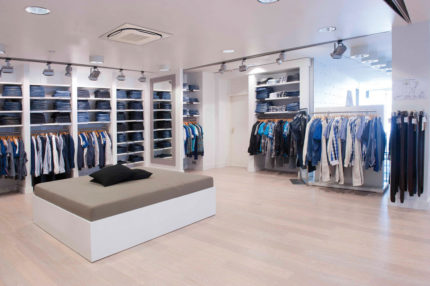
Industrial group includes various modifications of ducted air conditioning systems with a capacity of over 30 kW. Climatic equipment with similar characteristics is effectively used in shopping and entertainment centers, warehouses, industrial premises, which impose strict requirements on temperature and air purity.
When choosing an industrial system, its performance is first taken into account, and only then the attractiveness of external performance.
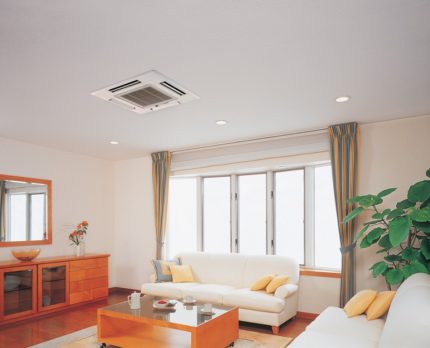
In addition to power, the classification of ceiling systems can relate to a number of characteristics:
- type of compressor;
- control system option;
- air filtration level;
- features of the location of the indoor unit.
Each type of equipment is functional and so choose the best ceiling split system, a number of criteria have to be considered.
Next, we will get acquainted with the features of the most popular types of air conditioners - cassette, duct and floor-to-ceiling.
View # 1 - cassette ceiling air conditioners
Systems of this category will be the best solution for spacious rooms of the correct geometry. Such equipment is used when the use of wall-mounted models is ineffective. Cassette systems, like many other air conditioners, are structurally composed of two units: external and internal.
The interior can be located anywhere in the room. The air ducts connecting the blocks are often laid in the subceiling space of a suspended ceiling.
The shape of the indoor unit allows you to easily install it instead of the decorative panel of the false ceiling.
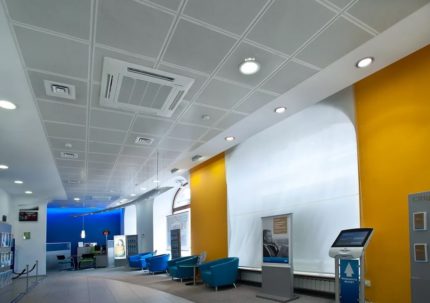
Due to the fact that the internal units of the cassette systems are integrated into the Armstrong suspended ceiling cells, the climate equipment is practically not noticeable, it does not spoil the interior.
Additional advantages of cassette air conditioners include:
- Uniform distribution of chilled air - achieved due to the fact that the flow from the cartridge flows in four directions.
- The absence of drafts, as happens with a wall split system.
- Installation of the front panel of the equipment on the same level with a decorative ceiling coating.
- Hidden laying of communications.
The only drawback of cassette systems is the reduction in height due to the installation of a false ceiling. Therefore, such equipment is used in shopping centers and other buildings where the ceiling height is 3 meters or more.
More on the pros and cons cassette split systems We told in our other article. Please follow the link and get acquainted in more detail with the features of this equipment.
View # 2 - channel split systems
This type of climatic equipment is similar to cassette air conditioners. As its additional advantage, it is worth noting the possibility mixture of fresh airtaken from the street. In fact, this equipment easily copes with the functions of supply and exhaust ventilation.
So that in the cold season, the room temperature does not fall below the desired, many models are equipped with equipment for heating the air.
Similar designs are relevant for rooms with a large area. The number of air channels can be adjusted depending on the needs of users. As with cassette systems, indoor units channel systems located in the subceiling space.
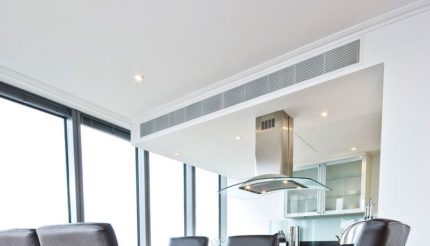
Air ducts are installed in the subceiling space. Their exit is closed by a decorative lattice. This is the only element that will be visible in the room. The fan, the heat exchanger of the evaporator is located in the internal part of the structure, it is completely hidden from prying eyes.
The advantages of channel systems include:
- the minimum number of visible elements that can spoil the interior;
- the ability to maintain the required temperature in one or more rooms;
- constant intake of fresh air.
The downside of channel air conditioning is the need to create a competent project, the ability to use the system in rooms with high ceilings.
View # 3 - floor-to-ceiling devices
Such systems have a wide range of applications. They can be installed on the ceiling, and, if necessary, used on the floor. The indoor unit of floor-to-ceiling air conditioners is very thin, so it does not cause a feeling of clutter of space. The design can work, settling down both in vertical, and in horizontal position.
Floor and ceiling models are characterized by wide functionality. They are able to cool, heat, clean the air flow, separate devices help get rid of excess moisture.
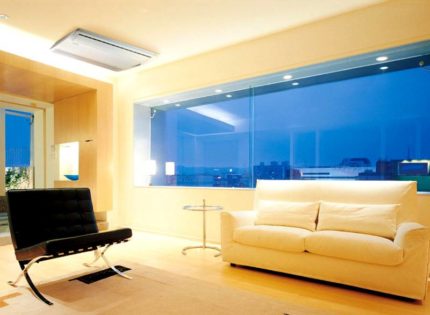
The indoor unit visually resembles a modern radiator. It is equipped with blinds that direct the blown air up or along the ceiling.
Systems equipped with a heat pump or equipped with heaters can heat the air. Convection flows can be cleaned by devices with filters in their construction.
Rules for installing ceiling air conditioners
Installation, adjustment of any ceiling air conditioner can be done independently, if you follow the basic rules:
- During installation, it is important to maintain cleanliness, no dust or debris should get into the nodes and piping.
- All connections must be airtight. The smallest hole in the air conditioning system can cause the climate equipment to malfunction.
- The external unit is recommended to be located slightly lower than the internal one.
- It is good if the outdoor unit will be in the shade most of the day. Otherwise, the energy consumption for the operation of the air conditioner will be much higher.
- During the installation of the air conditioner, try to leave the drain pipe as straight as possible, do not allow unnecessary excesses.
Before starting work, it is important to think about the attachment points for indoor and outdoor units, especially the laying of communications.
Installation of floor and ceiling systems
We will consider installation using the example of a floor-and-ceiling model - it is possible to install it on your own. But for the installation of the channel and cassette split systems, the help of specialists, as well as professional tools, will be required.
Stage # 1 - Preparing for Installation
At the preparatory stage, it is important to consider the order in which the installation will be carried out, to take into account the various nuances of the operation of HVAC equipment.
All fasteners must have a sufficient margin of safety. This is especially important for the outdoor unit, the mass of which can increase significantly as a result of icing, pollution.
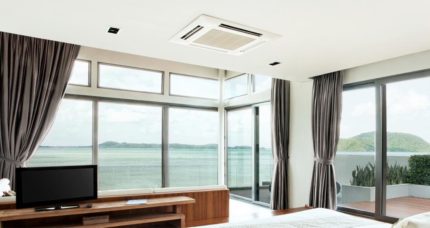
To connect the climate equipment, it is recommended to allocate a separate power line. The cross-section of the wire that supplies electricity must correspond to the power of the device with a margin.
Stage # 2 - choosing the location of the air conditioner
The presence of two or more blocks in a ceiling split system implies the need to choose a location for each. When installing HVAC equipment in a multi-story building, permission will be required.
Article 246 of the Civil Code confirms that a multi-storey building is a common property that all homeowners can dispose of. Therefore, the installation of an external unit without approval is considered a violation.
There are good reasons for this:
- the device is buzzing, disturbing the peace of neighbors;
- condensate can spoil the appearance of the facade, get to lower windows, balconies;
- the external unit can cover the review, spoil the view from the window;
- in the process of its installation, operation, there is a risk of cracking of the supporting structures, wiring shorting.
Decree No. 170 prohibits the installation of an external unit without the permission of the management company, the consent of neighbors. If the air conditioner is installed in a private house, a building owned, you can proceed with installation immediately after acquiring climate control equipment.
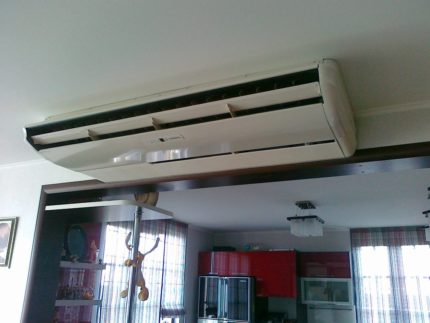
When choosing a location for an outdoor unit, it is important to consider the capabilities of the supporting structures. The device can be installed next to the window, on the wall, on the balcony or in the attic.
When installing the indoor unit, it is important to determine the approximate direction of air flow. Cooled air should spread evenly throughout the room, should not be directed to a recreation area or workplace.
Stage # 3 - installation of indoor and outdoor units
Installation of floor-ceiling split systems begins with the fixing of the indoor unit.
In this case, the following procedure is followed:
- Measurements are taken from the block.
- There is a steel mounting frame on the ceiling, horizontal and vertical alignment is checked with the help of a level.
- Marking of points is carried out, in the place of which fasteners will be placed.
- Using a punch, holes are made in which the dowels are fixed.
- The mounting plate is fixed on the ceiling, and the internal module is fixed on it.
In the process of carrying out work, it is important to check the conformity of the planes with the level. In the presence of distortions, condensate may accumulate in the sump.
The outdoor unit is attached from the street. Its mass is about 20 kg or more. To cope with the task, at least two installers are involved in work at heights.
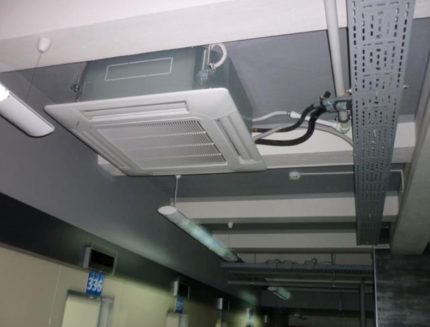
The installation procedure of the external module is similar to installing the internal:
- Marking the external wall.
- Creation of holes, installation of anchor bolts.
- Attaching brackets to anchors that hold the fixture.
- Checking the quality of mounting the frame, hanging an external unit on it.
When the outdoor module needs to be installed on the third floor or higher, it is worth contacting climbers.
Stage # 4 - laying communications of the air conditioner
The external and internal unit is connected by a communication system, which includes copper tubes for the movement of the refrigerant, electrical wires. Additionally, a drainage system is required to drain the condensate. All elements are important to correctly select, stack, securely fasten.
Since the ceiling air conditioner has a high energy consumption, a separate line is allocated for it, a residual current circuit breaker is installed. The cable section is selected based on the manufacturer's recommendations specified in the instructions for the device.
The following activities are carried out to create the pipeline:
- choppedpipe cutter copper pipe of the required length;
- the finished section is bent without kinks with a maximum radius of 10 cm, for which you can use pipe bender;
- the pipeline is going;
- polyurethane foam insulation is put on the pipe;
- the track is laid in a shtroba and fixed with dowels;
- The integrity and tightness of the assembled pipeline is checked.
To pass the route through the walls, ceilings, plugs must be installed at the ends of the pipes.
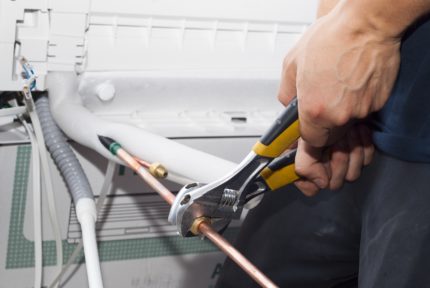
A drainage channel is formed from a piece of reinforced plastic tube. It connects to the sewer, but this is not the most popular way. Most often drainage channel take to the street.
Stage # 5 - System Health Check
Before starting the air conditioner, residual air and moisture are removed from the system. The procedure is called evacuation. To do this, use a vacuum pump or charge refrigerant with a slight excess. Freon is discharged from the external module, and air leaves the system with it.
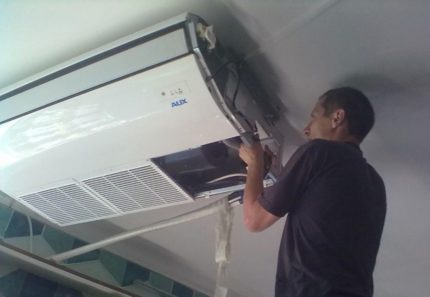
Performance testing of the air conditioner is carried out in the following order:
- the machine turns on, power is supplied;
- the system automatically enters test mode;
- checked the operation of the air conditioner for cooling, heating.
If the system does not fail, chilled air is evenly distributed throughout the room, you can close up the holes, clean the room, and enjoy the long-awaited coolness.
Setting the ceiling air conditioner
The main task of the air conditioner is to provide coolness in the room. As additional functions can be offered heating, cleaning, air drying, ventilation.
Setting the ceiling air conditioner to cold made using the remote control. Most often, it is indicated by a snowflake icon or a mark "Cool".
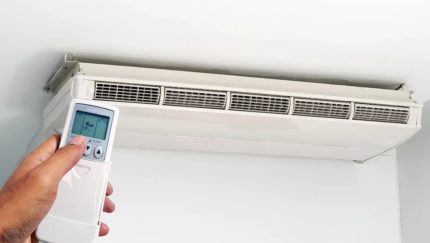
Using the remote control, it is easy to change the temperature to which the air will cool, the direction of its movement. It is best to set the blinds so that the cold stream moves along the ceiling, and is not directed at people in the room.
When setting the settings, keep in mind that the user can set individual parameters for the operation of HVAC equipment or stop automatically.
Conclusions and useful video on the topic
To install the ceiling air conditioner yourself, you must have professional equipment, specific skills. The rollers presented below will help you choose the best option for HVAC equipment, will talk in detail about the installation process.
The video will talk about the benefits of a cassette air conditioner:
Step-by-step installation instructions for the ceiling system:
Installation of the ceiling system, its adjustment requires compliance with building codes, specific knowledge and skills.If there are errors during installation, do not avoid difficulties during operation. Therefore, for the installation of an air conditioner, they most often turn to specialists of the company providing such services. Especially if climatic equipment is required to be installed on the third floor and above.
Do you have experience installing a ceiling air conditioner and want to know about the main nuances of other users? Share your tips in the comments. If you’re still thinking about it and don’t know whether it is worth doing the self-installation or if you still have questions about installing it, ask our specialists and other visitors to our site - the feedback block is located below.

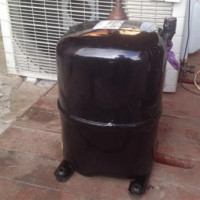 How to check the air conditioning compressor of a split system: nuances of diagnosis + tips for failure
How to check the air conditioning compressor of a split system: nuances of diagnosis + tips for failure 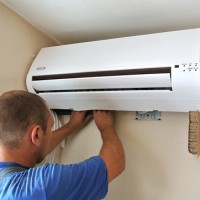 Do-it-yourself air conditioning installation: installation instruction + installation requirements and nuances
Do-it-yourself air conditioning installation: installation instruction + installation requirements and nuances 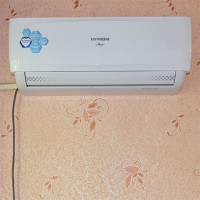 Hyundai H-AR21-09H split system review: heart core with a claim for a premium class
Hyundai H-AR21-09H split system review: heart core with a claim for a premium class 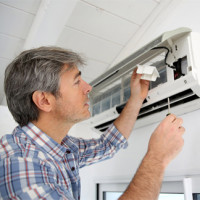 How to disassemble a split system with your own hands: features and procedures
How to disassemble a split system with your own hands: features and procedures 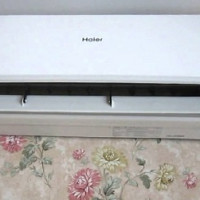 Haier HSU-07HTM03 / R2 split system overview: budget price tag with practical filling
Haier HSU-07HTM03 / R2 split system overview: budget price tag with practical filling 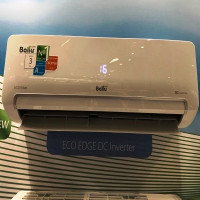 Overview of the Ballu BSLI-09HN1 split system: Chinese inverter technology
Overview of the Ballu BSLI-09HN1 split system: Chinese inverter technology  How much does it cost to connect gas to a private house: the price of organizing gas supply
How much does it cost to connect gas to a private house: the price of organizing gas supply  The best washing machines with dryer: model rating and customer tips
The best washing machines with dryer: model rating and customer tips  What is the color temperature of light and the nuances of choosing the temperature of the lamps to suit your needs
What is the color temperature of light and the nuances of choosing the temperature of the lamps to suit your needs  Replacement of a geyser in an apartment: replacement paperwork + basic norms and requirements
Replacement of a geyser in an apartment: replacement paperwork + basic norms and requirements